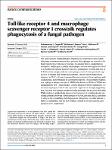Toll-like receptor 4 and macrophage scavenger receptor 1 crosstalk regulates phagocytosis of a fungal pathogen
| dc.contributor.author | Onyishi, CU | |
| dc.contributor.author | Desanti, GE | |
| dc.contributor.author | Wilkinson, AL | |
| dc.contributor.author | Lara-Reyna, S | |
| dc.contributor.author | Frickel, E-M | |
| dc.contributor.author | Fejer, G | |
| dc.contributor.author | Christophe, OD | |
| dc.contributor.author | Bryant, CE | |
| dc.contributor.author | Mukhopadhyay, S | |
| dc.contributor.author | Gordon, S | |
| dc.contributor.author | May, RC | |
| dc.date.accessioned | 2023-11-23T12:56:29Z | |
| dc.date.available | 2023-11-23T12:56:29Z | |
| dc.date.issued | 2023-08-14 | |
| dc.identifier.issn | 2041-1723 | |
| dc.identifier.issn | 2041-1723 | |
| dc.identifier.other | 4895 | |
| dc.identifier.uri | https://pearl.plymouth.ac.uk/handle/10026.1/21685 | |
| dc.description.abstract |
The opportunistic fungal pathogen Cryptococcus neoformans causes lethal infections in immunocompromised patients. Macrophages are central to the host response to cryptococci; however, it is unclear how C. neoformans is recognised and phagocytosed by macrophages. Here we investigate the role of TLR4 in the non-opsonic phagocytosis of C. neoformans. We find that loss of TLR4 function unexpectedly increases phagocytosis of non-opsonised cryptococci by murine and human macrophages. The increased phagocytosis observed in Tlr4−/− cells was dampened by pre-treatment of macrophages with oxidised-LDL, a known ligand of scavenger receptors. The scavenger receptor, macrophage scavenger receptor 1 (MSR1) (also known as SR-A1 or CD204) was upregulated in Tlr4−/− macrophages. Genetic ablation of MSR1 resulted in a 75% decrease in phagocytosis of non-opsonised cryptococci, strongly suggesting that it is a key non-opsonic receptor for this pathogen. We go on to show that MSR1-mediated uptake likely involves the formation of a multimolecular signalling complex involving FcγR leading to SYK, PI3K, p38 and ERK1/2 activation to drive actin remodelling and phagocytosis. Altogether, our data indicate a hitherto unidentified role for TLR4/MSR1 crosstalk in the non-opsonic phagocytosis of C. neoformans. | |
| dc.format.extent | 4895- | |
| dc.format.medium | Electronic | |
| dc.language | en | |
| dc.publisher | Springer Science and Business Media LLC | |
| dc.subject | Animals | |
| dc.subject | Humans | |
| dc.subject | Mice | |
| dc.subject | Cryptococcosis | |
| dc.subject | Cryptococcus neoformans | |
| dc.subject | Macrophages | |
| dc.subject | Phagocytosis | |
| dc.subject | Toll-Like Receptor 4 | |
| dc.subject | Scavenger Receptors, Class A | |
| dc.title | Toll-like receptor 4 and macrophage scavenger receptor 1 crosstalk regulates phagocytosis of a fungal pathogen | |
| dc.type | journal-article | |
| dc.type | Article | |
| plymouth.author-url | https://www.ncbi.nlm.nih.gov/pubmed/37580395 | |
| plymouth.issue | 1 | |
| plymouth.volume | 14 | |
| plymouth.publication-status | Published online | |
| plymouth.journal | Nature Communications | |
| dc.identifier.doi | 10.1038/s41467-023-40635-w | |
| plymouth.organisational-group | |Plymouth | |
| plymouth.organisational-group | |Plymouth|Research Groups | |
| plymouth.organisational-group | |Plymouth|Faculty of Health | |
| plymouth.organisational-group | |Plymouth|Research Groups|Institute of Translational and Stratified Medicine (ITSMED) | |
| plymouth.organisational-group | |Plymouth|Research Groups|Institute of Translational and Stratified Medicine (ITSMED)|CBR | |
| plymouth.organisational-group | |Plymouth|REF 2021 Researchers by UoA | |
| plymouth.organisational-group | |Plymouth|Users by role | |
| plymouth.organisational-group | |Plymouth|Users by role|Academics | |
| plymouth.organisational-group | |Plymouth|REF 2021 Researchers by UoA|UoA01 Clinical Medicine | |
| plymouth.organisational-group | |Plymouth|Faculty of Health|School of Biomedical Sciences | |
| plymouth.organisational-group | |Plymouth|Users by role|Researchers in ResearchFish submission | |
| plymouth.organisational-group | |Plymouth|REF 2028 Researchers by UoA | |
| plymouth.organisational-group | |Plymouth|REF 2028 Researchers by UoA|UoA01 Clinical Medicine | |
| dc.publisher.place | England | |
| dcterms.dateAccepted | 2023-08-03 | |
| dc.date.updated | 2023-11-23T12:56:26Z | |
| dc.rights.embargodate | 2023-11-24 | |
| dc.identifier.eissn | 2041-1723 | |
| rioxxterms.versionofrecord | 10.1038/s41467-023-40635-w |


